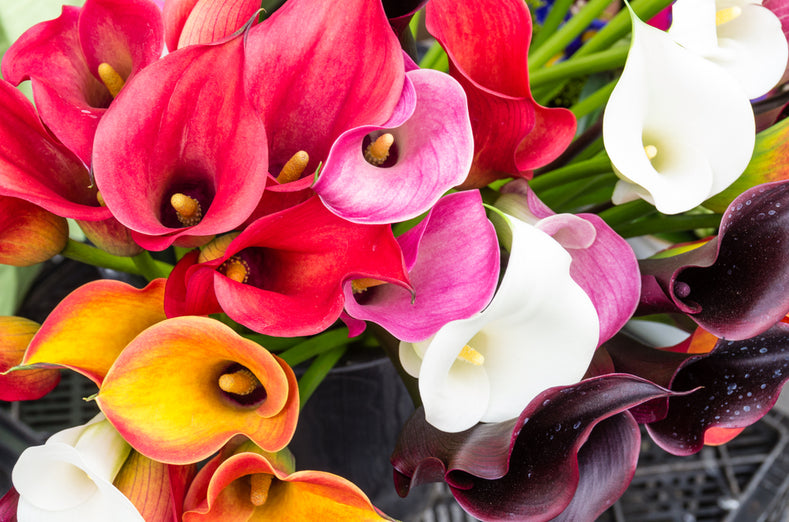Your Guide to Planning, Planting, and Growing Calla Lilies
About Calla Lilies
Calla lilies really are a beautiful addition to any setting. Classy and long lasting, they are available in myriad colors to suit all tastes and themes: from sunny yellow to eggplant purple, blush pink to rich velvet, sunset orange to blood red – as well as, of course, the classic bridal bouquet staple of pure white. It may be a pleasant surprise to learn that despite their exotic appearance, calla lily bulbs are actually easy to grow, and by following just a few simple steps you can be rewarded year after year with an abundance of their distinctive blooms.
Off To A Good Start
As with all plants, the better the bulb, the better the result. Smaller, older bulbs or rhizomes will yield dismal, poor quality flowers, whereas the large, fresh bulbs supplied by DutchGrown will guarantee a larger plant with a higher number of top-quality blooms.
When is the best time to plant Calla Lily Bulbs?
Calla lilies should be planted in the spring after any threat of frost has passed. In colder zones it is advisable to wait until the soil is at least 65°F, but if you are too impatient to wait you can always make a start by planting the bulbs in pots indoors about a month or so before planting them in the garden.
Zone
Calla lilies are winter hardy in zones 8-10. In colder areas they can either be grown as annuals or can be dug up in the fall and stored indoors for replanting the next spring (see our step-by-step guide on how to do this a little further down).
Do Calla Lilies like sun or shade?
In warmer zones, calla lilies grow well in full sun or partial shade. In cooler areas they thrive best in full sun.
Where to Plant Calla Lily Bulbs
Calla lilies are very versatile, thriving in beds and borders but also making a fantastic choice for planters and containers.
When planting in beds or borders, do bear in mind that some varieties can grow up to two feet tall, so it’s advisable to place them at the back or in the middle. It is worth noting that the distinctive speckled foliage remains attractive all season long, even after the plant has stopped blooming.
When planting in pots or containers, calla lilies generally perform better on their own. That’s not to say you shouldn’t plant them alongside other annuals, but for best results it’s fair to say that calla lilies prefer their own company.
If you have a cutting garden, then calla lilies really ought to take pride of place. Renowned for their long-lasting vase life – callas can last up to an impressive two weeks – they are also floriferous, providing an abundance of blooms throughout the season. It’s no wonder calla lilies are a firm favorite with florists.
How to Plant Calla Lilies
- Dig a hole around 3-4 inches deep (there is a general rule when planting bulbs and that is to give the bulbs at least 2 times their height of soil above them), drop the bulb in, and cover with soil. Make sure you place the bulb the right way up - the growing tips (also known as ‘eyes’) should be facing upwards.
- If planting in the ground, leave approximately 6 inches between each bulb. If you are planting in containers, you can space them a little closer together, around 4 inches or so.
- After planting, water well so that the soil above the bulbs settles. When the bulbs are first planted, it’s important to water sparingly. Once the plants have a few leaves, you can begin watering more generously.
- After planting, it may take 2 weeks or more for the first calla shoots to appear. Once that happens, the plants grow quickly.
- Calla lily bulbs will flower in Summer. After the flowers die down, allow the plant to enjoy a rest period - there is no need to water much during this period.

Some tips and hints to get the most out of your Calla Lily Bulbs
Soil quality
Like most plants, calla lilies should be grown in well-drained soil. For pots and containers, use a quality growing mix rather than garden soil.
Feeding Calla Lily Bulbs
During the growing season, calla lilies appreciate a monthly dose of liquid fertilizer – particularly if grown in containers.
After the flowering season
Zones 8-10
In warmer areas, calla lilies are winter hardy, and the bulbs may be left in the ground to bloom again the following summer. For optimum performance, the plants may need to be divided every few years.
Zones 3-7
In cooler areas, calla lilies are usually treated as annuals, with new bulbs planted each spring. The bulbs may be dug up and overwintered indoors, but you may not get the same results the second year.
If want to try saving your calla lilies for next year, follow these steps:
- Fertilize the plants throughout the growing season. Cut off the flower stems as soon as the blooms fade (by preventing the plants from setting seed, this will help conserve energy for next year’s flower).
- Continue fertilizing until the foliage begins to yellow.
- When the leaves have died back, dig up the bulbs and trim off any foliage, leaving an inch or two of stem attached. Leave the bulbs cure in a warm, dry place for several days and then put them into a box with very slightly damp peat moss. Keep the box stored in a dark place at 50-60°F. Check once or twice during the winter to make sure the rhizomes are not too moist – this will cause them to rot, or too dry – this will cause them to shrivel.
- Replant in spring.




